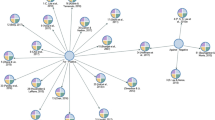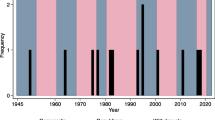Abstract
Economic voting theory assumes that on an individual level voters react to economic indicators to hold incumbents responsible for the performance of the economy. On an aggregate level, this would imply that there is an association between economic indicators and levels of volatility since voters have to switch parties if they want to punish or reward political actors. Based on a time-series cross-section analysis of the Pedersen Index for Western European countries in the period 1950–2013, we do indeed observe an association between economic indicators and levels of volatility. This effect furthermore grows stronger over time, and it is assumed that this is rendered possible by processes of partisan dealignment. The analysis suggests that European electorates are significantly more likely to shift parties in response to economic downturn now than they were a few decades ago.


Similar content being viewed by others
Notes
Data for GDP comes from the Total Economy Database (The Conference Board, 2013), providing comparative economic data for a wide set of countries from 1950 onwards. Yearly data on unemployment and inflation comes from the OECD database. For inflation, we include the logged inflation rate in the models.
Following the formula proposed by Bélanger and Gélineau (2010, p. 98), which we modify slightly to ensure a one-year time lag for the economic indicators: ρ=[ρ (t−2)*(12−σ (t))/12]+[ρ (t−1)*(σ (t)/12], where ρ is the annual economic indicator, σ is the election month and t is the election year. Data for GDP comes from the Total Economy Database, providing comparative economic data for a wide set of countries from 1950 onwards.
The Bormann and Golder (2013) data run until 2011; several online election sources were consulted to complete the data on district magnitude for elections after 2011.
It is important to point out that the results presented are robust to controlling for the impact of systems in the data set that are either presidential (Cyprus) or semi-presidential (France and Portugal).
This exact specification is also used by Kayser and Wlezien (2011) in their aggregate-level analysis of the impact of partisanship on economic voting.
Although all the indicators related to the electoral and party system are clearly closely related, zero-order correlations between these indicators (Least squares index of disproportionality, ENEP e−1, average district magnitude (ln) and electoral system change) are not too high. The Pearson correlation between district magnitude and the least squares index is −0.527, but other correlations are 0.2 or lower.
Effects presented are quantities of interest from 1000 simulated observations, obtained through the Clarify-command in Stata (King et al, 2000). Simulations based on OLS Huber White estimation.
References
Allison, P.D. (2009) Fixed Effects Regression Models. London: Sage.
Bartolini, S. and Mair, P. (1990) Identity, Competition, and Electoral Availability. The Stabilisation of European Electorates 1885–1985. Cambridge, UK: Cambridge University Press.
Beck, N. (2001) Time-series-cross-section data: What have we learned in the past few years? Annual Review of Political Science 4: 271–293.
Beck, N. and Katz, R.N. (1995) What to do (and not to do) with time-series-cross-section data. American Journal of Political Science 89(3): 634–647.
Bélanger, E. and Gélineau, F. (2010) Does perceived competence matter? Political parties and economic voting in canadian federal elections. Journal of Elections, Public Opinion and Parties 20(1): 83–101.
Bellucci, P., Costa Lobo, M. and Lewis-Beck, M.S. (2012) Economic crisis and elections: The European periphery. Electoral Studies 31(3): 469–471.
Bengtsson, A. (2004) Economic voting: The effects of political context, volatility and turnout on voters’ assignment of responsibility. European Journal of Political Research 43(5): 749–767.
Berglund, F., Holmberg, S., Schmitt, H. and Thomassen, J. (2005) Party identification and party choice. In: J. Thomassen (ed.) The European Voter. A Comparative Study of Modern Democracies. Oxford, UK: Oxford University Press, pp. 105–123.
Birch, S. (2003) Electoral Systems and Political Transformation in Post-Communist Europe. Basingstoke, UK: Palgrave Macmillan.
Bischoff, C.S. (2013) Electorally unstable by supply or demand? An examination of the causes of electoral volatility in advanced industrial democracies. Public Choice 156(3): 537–561.
Blais, A. and Gschwend, T. (2010) Strategic defection across elections, parties and voters. In: R.J. Dalton and C.J. Anderson (eds.) Citizens, Context and Choice. How Context Shapes Citizens’ Electoral Choice. Oxford, UK: Oxford University Press, pp. 176–196.
Bloom, H.S. and Price, H.D. (1979) Voter response to short-run economic conditions: The asymmetric effect of prosperity and recession. American Political Science Review 69(4): 1240–1454.
Bormann, N.-C. and Golder, M. (2013) Democratic electoral systems around the world, 1946–2011. https://files.nyu.edu/mrg217/public/elections.html, accessed 15 July 2013.
Bowler, S., Lanoue, D.J. and Savoie, P. (1994) Electoral systems, party competition, and strength of partisan attachment: Evidence from three countries. Journal of Politics 56(4): 991–1007.
Chappell, H.W.J. and Veiga, L.G. (2000) Economics and elections in Western Europe: 1960–1997. Electoral Studies 19(2/3): 183–197.
Crewe, I. and Denver, D. (1985) Electoral Change in Western Democracies: Patterns and Sources of Electoral Volatility. London: Croom Helm.
Dalton, R.J. (1984) Cognitive mobilization and partisan dealignment in advanced industrial democracies. Journal of Politics 46(1): 264–284.
Dalton, R.J., McAllister, I. and Wattenberg, M. (2000) The consequences of partisan dealignment. In: R.J. Dalton and M. Wattenberg (eds.) Parties Without Partisans. Oxford, UK: Oxford University Press, pp. 37–63.
Dassonneville, R. and Lewis-Beck, M.S. (2013) Economic policy voting and incumbency: Unemployment in Western Europe. Political Science Research and Methods 1(1): 53–66.
Dassonneville, R. and Lewis-Beck, M.S. (2014) Macroeconomics, economic crisis and electoral outcomes: A national European pool. Acta Politica 49(4): 372–394.
Drukker, D.M. (2003) Testing for serial correlation in linear panel-data models. The Stata Journal 3(2): 168–177.
Drummond, A.J. (2006) Electoral volatility and party decline in Western democracies: 1970–1995. Political Studies 54(3): 628–647.
Duch, R.M. and Stevenson, R.T. (2008) The Economic Vote: How Political and Economic Institutions Condition Electoral Results. New York: Cambridge University Press.
Epperly, B. (2011) Institutions and legacies: Electoral volatility in the postcommunist world. Comparative Political Studies 44(7): 829–853.
Erikson, R.S. and Wlezien, C. (2012) The Timeline of Presidential Elections. How Campaigns Do (And Do Not) Matter. Chicago, IL: University of Chicago Press.
Evans, G. and Tilley, J. (2011) How parties shape class politics: Explaining the decline of the class basis of party support. British Journal of Political Science 42(01): 137–161.
Evans, G. and Tilley, J. (2012) The depoliticization of inequality and redistribution: Explaining the decline of class voting. Journal of Politics 74(4): 963–976.
Franklin, M.N. (2004) Voter Turnout and the Dynamics of Electoral Competition in Established Democracies Since 1945. Cambridge, UK: Cambridge University Press.
Franklin, M., Mackie, T. and Valen, H. (2009) Electoral Change. Responses to Evolving Social and Attitudinal Structures in Western Countries. Colchester, UK: ECPR Press.
Freire, A. and Costa Lobo, M. (2005) Economics, ideology and vote: Southern Europe, 1985–2000. European Journal of Political Research 44(4): 493–518.
Gallagher, M. (1991) Proportionality, disproportionality and electoral systems. Electoral Studies 10(1): 33–51.
Gallagher, M. (2013) Election indices dataset. http://www.tcd.ie/Political_Science/staff/michael_gallagher/ElSystems/index.php, accessed 15 July 2013.
Gallagher, M., Laver, M. and Mair, P. (2011) Representative Government in Modern Europe. New York: McGraw-Hill.
Hibbs, D.A. (1987) The American Political Economy. Cambridge, MA: Harvard University Press.
Hooghe, M. and Kern, A. (2013) Party membership and closeness and the development of trust in political institutions an analysis of the European social survey, 2002–2010. Party Politics, advance in publication 27 January 2013 doi:10.1177/1354068813509519.
Katz, R.S., Rattinger, H. and Pedersen, M.N. (1997) The dynamics of European party systems. European Journal of Political Research 31(1): 83–97.
Kayser, M.A. and Wlezien, C. (2011) Performance pressure: Patterns of partisanship and the economic vote. European Journal of Political Research 50(3): 365–394.
Kennedy, P. (2012) From unpopular socialists to the popular party: The Spanish general election of 2011. West European Politics 35(3): 673–681.
Key, V.O. (1966) The Responsible Electorate. New York: Vintage.
King, G., Tomz, M. and Wittenberg, J. (2000) Making the most of statistical analyses: Improving interpretation and Presentation. American Journal of Political Science 44(2): 341–355.
Lewis-Beck, M.S. (2006) Does economics still matter? Econometrics and the vote. Journal of Politics 68(1): 208–212.
Lewis-Beck, M.S. and Stegmaier, M. (2000) Economic determinants of electoral outcomes. Annual Review of Political Science 3: 183–219.
Lipset, S.M. and Rokkan, S. (1967) Party Systems and Voter Alignments: Cross-National Perspectives. New York: Free Press.
Mackie, T.T. and Rose, R. (1991) The International Almanac of Electoral History. London: Macmillan.
Mainwaring, S. and Zoco, E. (2007) Political sequences and the stabilization of interparty competition: Electoral volatility in old and new democracies. Party Politics 13(2): 155–178.
Mair, P. (1993) Myths of electoral change and the survival of traditional parties. European Journal of Political Research 24(2): 121–133.
Mair, P. (2005) Democracy Beyond Parties. Irvine (UC): Center for the Study of Democracy.
Mair, P. (2008) Electoral volatility and the Dutch party system: A comparative perspective. Acta Politica 43(2/3): 235–253.
Nadeau, R., Lewis-Beck, M.S. and Bélanger, E. (2013) Economics and elections revisited. Comparative Political Studies 46(5): 551–573.
Nannestad, P. and Paldam, M. (1997) The grievance asymmetry revisited: A micro study of economic voting in Denmark, 1986–1992. European Journal of Political Economy 13(1): 81–99.
Ocaña, F.A. (2007) An approximation problem in computing electoral volatility. Applied Mathematics and Computation 192(2): 299–310.
Pedersen, M.N. (1979) The dynamics of European party systems: Changing patterns of electoral volatility. European Journal of Political Research 7(1): 1–26.
Powell, E.N. and Tucker, J.A. (2014) Revisiting electoral volatility in post-communist countries: New data, new results and new approaches. British Journal of Political Science 44(1): 123–147.
Powell, B.G. and Whitten, G.D. (1993) A cross-national analysis of economic voting: Taking account of the political context. American Journal of Political Science 37(2): 391–414.
Roberts, K.M. and Wibbels, E. (1999) Party systems and electoral volatility in Latin America: A test of economic, institutional, and structural explanations. American Political Science Review 93(3): 575–590.
Schäfer, A. and Streeck, W. (2013) Politics in the Age of Austerity. Cambridge, MA: Polity Press.
Sikk, A. (2005) How unstable? Volatility and the genuinely new parties in Eastern Europe. European Journal of Political Research 44(3): 391–412.
Singer, M. (2011) Who says ‘it’s the economy?’ Cross-national and cross-individual variation in the salience of economic performance. Comparative Political Studies 44(3): 284–312.
Söderlund, P. (2008) Retrospective voting and electoral volatility: A nordic perspective. Scandinavian Political Studies 31(2): 217–240.
Tavits, M. (2005) The development of stable party support: Electoral dynamics in post-communist Europe. American Journal of Political Science 49(2): 283–298.
The Conference Board. (2013) Total economy database. Total GDP, in millions of 1990 US$ (converted at Geary Khamis PPPs). http://www.conference-board.org/data/economydatabase/, accessed 15 July 2013.
Thomassen, J. and Rosema, M. (2009) Party identification revisited. In: J. Bartle and P. Bellucci (eds.) Political Parties and Partisanship: Social Identify and Individual Attitudes. London: Routledge, pp. 42–59.
van Biezen, I., Mair, P. and Poguntke, T. (2012) Going, going, … gone? The decline of party membership in contemporary Europe. European Journal of Political Research 51(1): 24–56.
van der Brug, W., van der Eijk, C. and Franklin, M. (2007) The Economy and the Vote: Economic Conditions and Elections in Fifteen Countries. New York: Cambridge University Press.
Vasilopoulou, S. and Halikiopoulou, D. (2013) In the shadow of the grexit: The Greek election of 17 june 2012. South European Society and Politics 18(4): 523–542.
Walczak, A., van der Brug, W. and de Vries, C. (2012) Short and long term determinants of party choice: Differences across generations. Electoral Studies 31(2): 273–284.
Wiggins, V. and Poi, B. (2013) How do I test for panel-level heteroskedasticity and autocorrelation? http://www.stata.com/support/faqs/statistics/panel-level-heteroskedasticity-and-autocorrelation/, accessed 15 June 2013.
Author information
Authors and Affiliations
Corresponding author
Appendix
Rights and permissions
About this article
Cite this article
Dassonneville, R., Hooghe, M. Economic indicators and electoral volatility: economic effects on electoral volatility in Western Europe, 1950–2013. Comp Eur Polit 15, 919–943 (2017). https://doi.org/10.1057/cep.2015.3
Published:
Issue Date:
DOI: https://doi.org/10.1057/cep.2015.3




